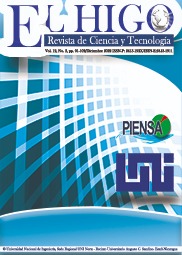Glucose oxidase an alternative in the preservation of beverages
DOI:
https://doi.org/10.5377/elhigo.v12i2.15192Keywords:
GOX, PPO, conservation, apple juice, apple nectarAbstract
GOX has been widely used as a food additive due to its properties, however, there is no scientific literature reporting its effects on the preservation of beverages prepared from fruits. The objective of the research was to confirm the preservative potential of a GOX extract, to prevent browning in apple juice and advantage the production of hydrogen peroxide as antimicrobial in apple nectar. Four treatments were applied to the juice to determine the antioxidant activity of GOX; the first with an enzyme concentration of 64.5 mg/mL, the second with 129 mg/mL of the enzyme solution, the third with ascorbic acid (64.5 mg/mL) and a fourth without additive (control) and then the percentage of inhibition was determined. In the case of pasteurized natural nectar, without additives or glucose, an experiment was conducted under a factorial arrangement of two GOX concentrations (64.5mg/L and 129mg/L) and two temperatures (4°C and 37°C), evaluated in four storage times (0, 24, 48 and 72 hours), and the oxidizing potential of GOX was determined through the production of H2O2. An inhibitory effect of GOX on enzymatic browning was found in apple juice. In addition, the statistically significant effect between GOX concentration and incubation time on the production of hydrogen peroxide in the nectar was confirmed, corroborating the enzyme's potential as a preservative.
Downloads
References
Alonso M. y Delfín J. (2002). Purificación parcial de Glucosa Oxidasa a partir del hongo Penicillium funiculosum. Revista Biológica, 16(2): 15-19.
Baduí S. Química de los alimentos. 4ta edición. Editorial Pearson. Mexico. 2006
Dontorou C., Papadopoulou C., Filioussis G., Economou V., Apostolou I., Zakkas G., Salamoura A., Kansouzidou A., Levidiotou S. (2013). Isolation of Escherichia coli O157:H7 from foods in Greece, International Journal of Food Microbiology. 82(3): 273-279.
Essary, A. (2021). Enzymatic Management of High pH Grape Juice and Must & The Effects of Crop Thinning on Grape Yield and Wine Quality. Master's thesis, Texas A&M University. Disponible: https://oaktrust.library.tamu.edu/handle/1969.1/193306
El-Rashidy, L., Bahlol, H., y El-Desoky, A. (2015). Improving Quality of Pan Bread by Using Glucose Oxidase and Lipase Enzymes. Middle East J. Appl. Sci., 5, 1035–1043.
Li, X., Xie, X., Xing, F., Xu, L., Zhang, J., and Wang, Z. (2019). Glucose oxidase as a control agent against the fungal pathogen Botrytis cinerea in postharvest strawberry. Food Control 105:277-284.
Marshall M., Kim J., y Wei C. (2000). Enzymatic Browning in Fruits, Vegetables and Seafoods, Vol. 5, University of Florida, Gainesville, FL, USA, 2000.
Martinez, M. y Whitaker, J. (1995). The biochemistry and control of enzymatic browning. Trends Food Sci. Technol. 1995, 6, 195–200.
Mayer, A. y Harel, E. (1979). Polyphenol oxidases in plants. Phytochemistry. 18, 193–215
Noguera N., Ojeda L., Velásquez I., Ramírez N., Yépez A. (2013). Efecto de tres Condiciones de Pasteurización sobre la Actividad Enzimática y Antimicrobiana de un Extracto de Glucosa Oxidasa. Revista de la Sociedad Mexicana de Biotecnología y Bioingenieria A.C
Noguera N., Hernández A., Jiménez A., Requena D., Ojeda L. (2014). Efecto del sistema glucosa oxidasa/glucosa sobre el crecimiento de Escherichia coli ATCC 25922 en leche. Revista Venezolana de Ciencia y Tecnología de Alimentos 5(1): 57-69
Noguera-Machado N., Ojeda L.; Peréz-Ybarra L., Brett M., García K.; Yépez A. y Triana J. (2018). Efecto de la combinación de glucosa oxidasa/ Glucosa sobre el crecimiento de bacterias del género Salmonella aisladas de aves de corral. Rev. U.D.C.A Actualidad. & Divulgación Cientifica.21 (1): 127-136.
Norma COVENIN 1151-77. Determinación de acidez titulable. Disponible en: http://www.sencamer.gob.ve/sencamer/normas/1151-77.pdf
Norma COVENIN 1315-79. Determinación de pH. Disponible en: http://www.sencamer.gob.ve/sencamer/normas/1315-79.pdf
Norma COVENIN 1030-95. Jugos y Néctares, características generales. Disponible en: http://www.sencamer.gob.ve/sencamer/normas/1030-95.pdf
Ojeda L, Noguera N., Triana J. y Triana-Alonso F. (2011). Evaluación del potencial como aditivo en alimentos de un extracto de glucosa oxidasa y catalasa producido a partir de Aspergillus niger en un medio a base de fertilizantes y azúcar industrial. Revista: Revista de la Sociedad Mexicana de Biotecnología y Bioingeniería A.C.
Petkova V., Mladenoska I., Gjuladin-Hellon G. (2016). Utilization of Different Types of Glucose Oxidase for Reduction of Glucose Concentration in Synthetic Grape Juice. Agro-knowledge Journal. 17(1): 47-58.
Downloads
Published
How to Cite
Issue
Section
License
Copyright (c) 2022 Universidad Nacional de Ingeniería

This work is licensed under a Creative Commons Attribution-NonCommercial-NoDerivatives 4.0 International License.
Los artículos publicados en la revista El Higo, Nicaragua, se comparten bajo términos de la licencia Creative Commons: Reconocimiento, No Comercial, Compartir Igual. que permite a terceros utilizar lo publicado siempre que mencionen la autoría del trabajo y a la primera publicación en esta revista. ![]()
Los autores/as pueden realizar otros acuerdos contractuales independientes y adicionales para la distribución no exclusiva de la versión del artículo publicado en esta revista (p. ej., incluirlo en un repositorio institucional o publicarlo en un libro) siempre que indiquen claramente que el trabajo se publicó por primera vez en esta revista.







